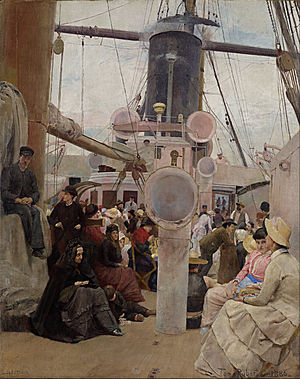| Coming South | |
|---|---|
 | |
| Artist | Tom Roberts |
| Year | 1886 |
| Medium | oil on canvas |
| Dimensions | 63.5 cm× 52.2 cm(25.0 in× 20.6 in) |
| Location | National Gallery of Victoria, Melbourne |
Coming South is a 1886 painting by the Australian artist Tom Roberts. The painting depicts migrants coming to Australia from Europe aboard a steamship. Roberts based the painting on sketches he had made when returning to Australia aboard the SS Lusitania in 1885 after four years abroad in Europe. [1]
Historian Humphrey McQueen describes Coming South as one of Roberts' seven best-known paintings. [2] The National Gallery of Victoria describes it as "a definitive image of the migrant experience" and "Roberts's first exploration of one of the great themes of Australian life". [3]
The painting was acquired by the National Gallery of Victoria in 1967. [3]